Painting the exterior of your home is one of the best ways to boost curb appeal and protect your property from the elements. But before the first coat goes on, many Washington homeowners wonder whether they need to repair their siding first. The simple answer is yes—most homes benefit from at least some level of siding repair before a new paint job. In fact, skipping this step can lead to peeling paint, moisture damage, and wasted time and money.
Washington’s climate brings heavy rain, moisture, and seasonal temperature shifts, all of which can wear down siding faster than many homeowners expect. This makes surface preparation more important than ever. Many people choose to work with exterior painting specialists who understand how moisture affects paint longevity, especially in western parts of the state.
Below is a practical checklist to help you decide whether your siding needs repair before you begin painting.
Check for Rot, Soft Spots, and Moisture Damage
Moisture is one of the biggest threats to siding in Washington. Wood siding, in particular, can develop soft spots, discoloration, and spongy areas as rainwater seeps in. Even fiber cement or engineered wood can absorb moisture if cracks or gaps go unrepaired.
Take a screwdriver or small tool and gently press the siding in different areas. If it sinks in or feels soft, that’s a clear sign of rot or water damage. These sections must be replaced before painting. If not, paint won’t adhere properly and the deteriorated wood will continue to spread.
Moisture damage is especially common near the bottom edges of siding, around windows, and anywhere water tends to sit. A quick inspection can save you from much larger repairs down the road.
Look for Cracks, Holes, and Gaps
Cracks or holes—even small ones—can cause problems. When water enters these openings and dries repeatedly, it causes expansion and contraction, eventually causing the paint to peel. Small gaps around window trim, doors, and corners can allow wind-driven rain to seep behind siding, which leads to trapped moisture.
Before painting, seal gaps with appropriate caulking and repair or replace cracked boards. Paint adheres best to smooth, sealed surfaces. Washington’s rainy season makes it even more important to close these gaps tightly to protect the underlying structure.
Examine the Caulking Around Trim and Seams
Caulking plays a major role in protecting your home from water intrusion. Over time, caulk dries out, cracks, or pulls away from surfaces. This allows moisture to sneak in between siding panels and trim boards.
Run your hand along seams, trim edges, and joints. Look for:
- Cracking or peeling caulk
- Areas where caulk has shrunk and created gaps
- Missing caulk around windows or door frames
Re-caulking is an inexpensive step that pays off in better protection and longer-lasting paint results. It helps create a clean, sealed surface that paint can bond to more effectively.
Check for Mold, Mildew, and Algae Growth
In Washington’s damp climate, mold and algae often appear on siding, especially on shaded sides of the home or areas with poor airflow. These growths must be removed with proper cleaning solutions before any painting begins. Paint cannot stick to mold or mildew, and leaving it in place traps moisture beneath the surface.

Inspect for Warping or Buckling Boards
Warped, bowed, or buckled boards are signs that siding has been exposed to moisture or extreme temperature changes. Warping often compromises the structure, allowing water to get behind the siding and cause deeper problems.
If boards are significantly curved or pulling away from the wall, replacing them is usually the safest option. Painting over warped siding only seals in the problem, and the paint will crack or peel early.
Homeowners often reach out to experienced painting crew familiar with home exteriors when they find warped areas, since improper replacement can lead to uneven surfaces and gaps.
Test Paint Adhesion on Older Surfaces
If your home hasn’t been painted in many years, it’s smart to test how well the existing paint is still bonded to the siding. Use a simple adhesion test: score a small grid pattern into the paint, apply tape, and pull it off. If paint flakes away easily, the siding needs scraping, sanding, or repair before the new coat can go on.
Poor adhesion is common on homes exposed to long-term moisture or sun damage. Fixing these areas before painting ensures a smoother, more durable finish.
Clean the Siding Thoroughly Before Painting
Even if the siding doesn’t need major repairs, it must be cleaned before painting. Dirt, pollen, dust, and airborne debris can cover siding and prevent paint from bonding properly. Pressure washing is often used to remove grime, but homeowners should be careful not to spray water into gaps or force moisture behind the siding.
A clean surface allows painters to spot hidden problems such as hairline cracks, small rot spots, or areas where caulk is missing.
Address Loose or Missing Boards
Over time, siding nails can loosen, and boards may shift due to Washington’s weather cycles. Loose boards should be re-secured, and missing siding pieces should always be replaced before painting begins.
Painting over loose sections leads to paint failure as soon as the siding moves again. Secure siding also ensures the home is well-protected during periods of high winds and rain.
When Should Homeowners Contact a Professional?
Some repairs like caulking, light sanding, or small patchwork can be handled by handy homeowners. However, issues like deep rot, widespread warping, or major water damage require expert attention. These problems often indicate structural issues behind the siding that need to be addressed by someone who understands both siding repair and paint preparation.
Many homeowners feel more confident after talking with local exterior experts who can walk them through the prep process, especially when they’re unsure about hidden damage or moisture issues.
Conclusion: Siding Repair Is the Foundation of a Lasting Paint Job
Painting your home’s exterior is an investment, and repairing siding beforehand ensures you get the most out of that investment. In Washington’s climate, moisture, temperature changes, and outdoor exposure can wear down siding faster than expected. Taking time to inspect, repair, and prepare the surface helps the new paint bond better, last longer, and protect your home more effectively.
A strong paint job begins long before the first stroke of the brush. With the right preparation—and help from knowledgeable exterior professionals when needed—you can enjoy a fresh, long-lasting finish that improves your home’s curb appeal and durability for years to come.

